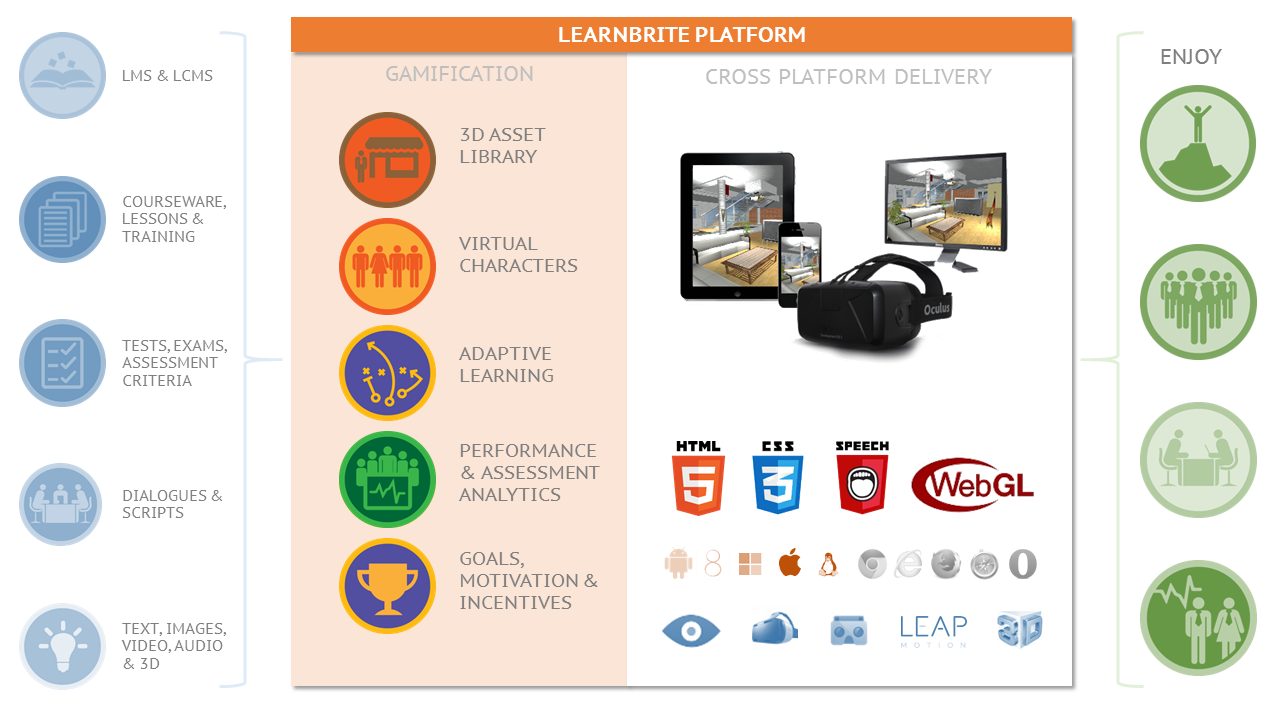The demand for virtual education has steadily increased, necessitating reliable and effective online learning platform software. These platforms offer a range of benefits and features that can significantly enhance the learning process for educators and learners alike.
This blog post will explore the numerous advantages of online learning platform software solutions, including cost savings, increased engagement, and improved accessibility. We will also delve into various types of these platforms, such as self-paced courses, instructor-led courses, and micro-learning modules.
Furthermore, we’ll discuss essential features like gamified learning experiences, role-play simulations, and immersive 3D experiential scenarios that contribute to an enriching educational experience. Lastly, you’ll learn about crucial considerations when choosing an online learning platform software solution and best practices for successful implementation in your organization or educational institution.
Table of Contents:
- Benefits of Online Learning Platform Software
- a. Cost Savings
- b. Increased Engagement
- c. Improved Accessibility
- Types of Online Learning Platform Software
- Features of Online Learning Platform Software
- Considerations When Choosing an Online Learning Platform Software Solution
- Best Practices for Implementing an Online Learning Platform Software Solution
- Frequently Asked Questions Online Learning Platform Software
- Conclusion
1. Benefits of Online Learning Platform Software
Online learning platform software has revolutionized how instructional designers, learning and development professionals, and e-learning agencies create and deliver educational content. By leveraging technology, these platforms offer a range of benefits, such as cost savings, increased engagement, and improved accessibility for learners.
a. Cost Savings
Using online learning platform software can lead to significant cost savings for organizations compared to traditional classroom-based training methods. With an e-learning platform in place, no travel expenses or venue rental costs are involved. Additionally, online courses can be easily updated without reprinting materials or hiring instructors for each session.
b. Increased Engagement
E-learning platforms enable instructional designers to create interactive and engaging content that keeps learners interested throughout their training journey. Features like gamification elements (badges, points), multimedia resources (videos, audio clips), quizzes and assessments help maintain learner motivation while maximizing knowledge retention.
c. Improved Accessibility
- Geographical boundaries: Online learning platform software allows learners from different locations to access course materials whenever they prefer – all they need is a stable internet connection.
- Pace flexibility: E-training platforms cater to diverse learner needs by offering self-paced courses that allow individuals with varying schedules or abilities to learn at their own pace without feeling overwhelmed or left behind.
- Diverse devices: Most modern education platform software solutions are designed with mobile compatibility in mind so that users can access them on smartphones or tablets alongside desktop computers – ensuring a seamless learning experience across devices.
In conclusion, online learning platform software has numerous benefits for instructional designers and e-learning agencies. From cost savings to increased engagement and improved accessibility, these platforms provide an effective way to create and deliver educational content that meets the needs of today’s learners.

Using online learning platform software offers many benefits, such as cost savings, increased engagement and improved accessibility. Let’s explore the varied options of virtual education platforms accessible to us, considering their potential advantages.
Key Takeaway:
This project aims to develop a no-code platform for creating immersive 3D learning scenarios that can be used for various types of online training, such as micro-learning modules, employee onboarding, and gamified learning. The software will enable users to design engaging role-play simulations and soft skills training without needing advanced technical skills or knowledge.
2. Types of Online Learning Platform Software
It is important to be familiar with the various online learning platforms that can be used for varied educational goals. This section will explore three popular types: self-paced courses, instructor-led courses, and micro-learning modules.
a. Self-Paced Courses
Self-paced courses are designed for learners who prefer flexibility in their study schedules or have varying levels of prior knowledge on a subject matter. These courses allow students to progress at their own pace, providing ample time to absorb information without feeling overwhelmed by deadlines or peer pressure. E-learning platform software like LearnBrite enables course creators to develop engaging multimedia content such as videos, quizzes, simulations and more that can be accessed anytime from anywhere.
b. Instructor-Led Courses
In contrast with self-paced courses, instructor-led courses foster real-time interaction between educators and learners through live webinars or virtual classrooms facilitated by an expert in the field. This e-training platform allows participants to ask questions directly during sessions while benefiting from immediate feedback on assignments or assessments provided by instructors. Converting traditional classroom training into online formats makes it easier for organizations worldwide to provide professional development opportunities regardless of geographical constraints.
c.Micro-Learning Modules
- Bite-sized lessons: Micro-learning modules consist of short, focused lessons that cover specific topics or skills. This format is ideal for busy professionals who may not have the time to commit to lengthy courses.
- Just-in-time learning: These modules can be accessed on-demand, allowing learners to find and review relevant information when needed quickly.
- Increased retention: Research suggests that breaking down complex subjects into smaller chunks helps improve knowledge retention rates. Micro-learning modules enhance long-term memory recall by offering concise content in easily digestible formats.
In conclusion,
To cater to diverse learning needs and preferences, e-learning software platforms like LearnBrite offer a range of options, including self-paced courses, instructor-led courses, and micro-learning modules. Understanding these types will help instructional designers create more effective training programs tailored to their target audience’s requirements.
Online learning platform software, online learning, online learning platforms, learning platform, learning online, learning management systems, learning process, distance learning, Google Classroom, educational institutions, and learning styles are all related to digital education and the process of acquiring knowledge or skills through digital resources and online platforms.
The online learning platform software types discussed in this article are a great way to create engaging and effective courses for learners and the learning process. Let’s delve deeper into the capabilities of these platforms, which can further bolster user engagement and learning online.

Distance learning, also known as remote or online learning, is a method of education where learners participate in educational activities from a location separate from the instructor or educational institution. The learning process in distance learning typically involves accessing digital resources, engaging in virtual discussions or interactions, and completing assignments or assessments remotely.
Key Takeaway:
This project aims to develop a no-code platform that enables the creation of immersive 3D learning scenarios for various online courses, such as micro-learning modules and employee onboarding. The software will provide learners with an engaging and interactive experience through gamification and role-play simulations.
3. Features of Online Learning Platform Software
Online learning platform software offers a wide range of features that can enhance learners’ and instructors’ overall learning experience. These features make it easier to create engaging content and help deliver immersive, interactive, and effective training experiences. This section will discuss some key features of online learning platform software, such as gamified learning experiences, role-play simulations, and immersive 3D experiential learning scenarios.
a. Gamified Learning Experiences
Gamification is an essential feature of many e-learning software platforms, as it helps increase learner engagement and motivation by incorporating game elements into the educational content. Some common examples include point systems, badges or awards for completing tasks or achieving milestones, leaderboards to encourage peer competition, and customizable avatars to personalize the user experience.
- Points Systems: Assigning points based on performance encourages learners to strive for improvement while providing instant feedback on their progress.
- Badges/Awards: Recognizing achievements with virtual rewards can boost learner morale and promote a sense of accomplishment.
- Leaderboards: Displaying rankings fosters healthy competition among users while promoting goal-setting behaviors.
- Customizable Avatars: Allowing learners to customize their digital personas enhances personalization within the e-training platform environment.
b. Role-Play Simulations
An important aspect of any education platform software is its ability to provide realistic role-play simulations that allow learners to practice skills in a safe and controlled environment. Role-play simulations can benefit soft skills training, such as communication, negotiation, or conflict resolution. By providing a virtual space where learners can experiment with different approaches and strategies without real-world consequences, role-play simulations help build confidence in applying newly acquired knowledge to actual situations.
c. Immersive 3D Experiential Learning Scenarios
Immersive 3D experiential learning scenarios are an innovative feature offered by some online learning platform software, like LearnBrite. These scenarios provide realistic environments that enable learners to explore and interact with the content more engagingly than traditional text-based materials or videos alone could offer.
By utilizing cutting-edge technologies such as virtual reality (VR) and augmented reality (AR), immersive 3D experiential learning scenarios offer highly interactive experiences to facilitate a better understanding of complex concepts while promoting higher retention rates. Additionally, these scenarios often include branching narratives that adapt based on learner choices, ensuring personalized feedback tailored to individual needs.

The features of online learning platform software allow users to create immersive 3D experiential learning scenarios, gamified experiences and role-play simulations that are engaging and effective. When selecting an online learning platform software solution, it is important to consider ease of use and customization options, security and data protection, scalability and integration capabilities.
From immersive learning initiatives to always-on events, LearnBrite allows you to run evergreen experiences that delight attendees and generate sponsor leads on autopilot. Your Metaverse becomes a hub of engaging and interactive experiences that continue to captivate and inspire, providing continuous value and driving attendee engagement and sponsor opportunities without constant manual effort.
Key Takeaway:
This effort focuses on creating a no-code platform to fabricate immersive 3D educational circumstances for use in online courses, ranging from independent to instructor-guided ones. The software will allow users to design gamified learning experiences, role-play simulations and micro-learning modules for employee onboarding and soft skills training without needing any coding knowledge.
4. Considerations When Choosing an Online Learning Platform Software Solution
The right online learning platform software is crucial for instructional designers, learning and development professionals, and e-learning agencies to create engaging and effective training programs. To make an informed decision, consider the following key factors:
a. Ease of Use and Customization Options
An ideal e-learning platform software should be user-friendly for both learners and administrators. Look for a solution that offers a simple yet powerful interface with drag-and-drop functionality or no-code options like LearnBrite. Look for a solution that enables you to tailor the content to your organization’s requirements.
b. Security and Data Protection
Data security is paramount when it comes to any education platform software. Ensure the chosen solution complies with industry standards such as GDPR (General Data Protection Regulation) or FERPA (Family Educational Rights & Privacy Act). Investigate whether the provider has strong encryption protocols to protect sensitive information from unauthorized access.
c. Scalability and Integration Capabilities
A scalable e-training platform will allow your organization to grow without limitations by accommodating more users, courses, or modules as needed. Check for any restrictions on storage capacity or bandwidth usage before committing. Furthermore, integration capabilities play a significant role in streamlining workflows between different systems within your organization – including HRIS (Human Resource Information System), LMS (Learning Management System), CRM(Customer Relationship Management) etc., ensuring seamless data exchange across platforms.
- Evaluate the ease of use: Select an intuitive, user-friendly platform that simplifies content creation and customization.
- Ensure data security: Choose a solution with robust encryption protocols to protect sensitive information from unauthorized access.
- Consider scalability: Prioritize platforms that can accommodate growth in users, courses, or modules without limitations on storage capacity or bandwidth usage.
- Assess integration capabilities: Select a software learning platform that integrates seamlessly with your existing systems for streamlined workflows and efficient data exchange across platforms.
Considering these factors will help you select the most suitable online learning platform software for your organization’s needs. Investing in the right solution ensures an engaging and effective training experience for learners while maximizing your business’s return on investment (ROI).
In evaluating online e Learning online has become increasingly popular, with many educational institutions and organizations utilizing learning management systems (LMS) to deliver and manage online courses. LMS platforms provide a centralized hub for organizing and administering learning materials, tracking progress, and facilitating communication between instructors and learners. The learning process in an online environment typically involves creating and delivering digital content, engaging in discussions and interactions, and completing assessments or assignments.
Online learning platforms have become essential tools for modern education, providing access to a wide range of courses and resources for learners worldwide. Many educational institutions are incorporating online learning platforms into their curricula to enhance the learning experience. Some popular online learning platforms offer advanced features such as interactive lessons, quizzes, and discussion forums.
Students can access online learning platforms anytime, anywhere, making it convenient for self-paced learning. Online learning platforms are also used for corporate training, allowing organizations to provide professional development opportunities for their employees. As the demand for flexible and accessible education grows, online learning platforms continue to evolve and play a crucial role in learning. Overall, online learning platforms have revolutionized how people acquire knowledge and skills, making learning more convenient, engaging, and accessible.
Distance learning, which allows learners to participate remotely, is often facilitated through online platforms, including Google Classroom, which provides a virtual learning environment for educators and students to collaborate and access resources. Educational institutions, including schools, universities, and training organizations, utilize online learning tools and platforms to provide accessible and flexible learning opportunities for their learners.aching platform, criteria such as the convenience of use, personalization potentials, security and privacy safeguards, scalability and integrative capacities should be considered. Once the key factors have been considered, a successful approach can be devised to implement an online learning platform software solution.
Key Takeaway:
This project aims to develop a no-code platform that enables the creation of immersive 3D learning scenarios for various online courses and training programs. The software will allow users to produce engaging, interactive content without requiring advanced technical skills or knowledge.
5. Best Practices for Implementing an Online Learning Platform Software Solution
Implementing an online learning platform software solution like LearnBrite can be a game-changer for instructional designers, learning and development professionals, and e-learning agencies. To guarantee the success of your implementation, it is vital to adhere to practices that will enable you to amplify the effect of your new e-learning technologies.
a. Establish Clear Goals and Objectives
Before implementing any online learning platform software solution, it’s crucial to establish clear goals and objectives for your training program using online learning platforms. This includes identifying specific skills or knowledge gaps you want to address through e-learning content creation or selecting appropriate courses from existing libraries on education platform software like LearnBrite.
- Determine what learners should achieve by the end of each course/module (e.g., mastering a particular skill).
- Establish measurable performance indicators that align with business objectives (e.g., increased sales revenue).
- Create a timeline for achieving these goals/objectives within realistic timeframes.
b. Develop an Effective Training Strategy
An effective training strategy is key when using online learning platforms like LearnBrite to deliver engaging educational experiences tailored specifically towards individual learner needs/preferences:
- Select suitable delivery methods: Choose between self-paced courses, instructor-led sessions or microlearning modules based on factors such as learner preferences/availability & subject matter complexity.
- Leverage gamification & immersive elements: Utilize features offered by simple e-learning platforms like role-play simulations & immersive 3D experiential learning scenarios to increase learner engagement & knowledge retention.
- Personalize content: Customize e-learning materials to cater to different learning styles, cultural backgrounds & skill levels to ensure maximum relevance and effectiveness.
c. Utilize Available Resources to Maximize Impact
To make the most of your online learning platform software solution, you must take advantage of all available resources at your disposal:
- Technical support: Seek assistance from software providers like LearnBrite when encountering technical issues or requiring guidance on utilizing specific features within their e-training platforms.
- User communities & forums: Engage with fellow instructional designers/learning professionals via user groups dedicated to discussing experiences using particular education platform software solutions (e.g., LinkedIn Groups).
- Ongoing professional development opportunities: Attend webinars, workshops or conferences related directly toto enhancing skills/knowledge required to effectively implement online learning platform software tools such as LearnBrite into existing training programs/workflows.
Incorporating these best practices will help ensure a smooth implementation process while maximizing the potential benefits of an online learning platform software solution like LearnBrite. By establishing clear goals/objectives, developing effective training strategies and utilizing available resources/support networks, instructional designers can create engaging educational experiences tailored to meet individual learner needs/preferences – ultimately driving improved performance outcomes across organizations globally.
Key Takeaway:
This project aims to develop a no-code platform for creating immersive 3D learning scenarios that can be used in various online courses and training programs. The user-friendly platform will enable people without programming experience to generate magnetic and interactive material.
Frequently Asked Questions Online Learning Platform Software
What is an online learning platform?
An online learning platform is a digital environment that facilitates educational content delivery, management, and tracking. It enables learners to access courses and resources remotely, often through web-based applications or mobile devices. These platforms can support various learning experiences, such as self-paced courses, instructor-led training, and interactive simulations.
What are the learning platforms for software?
Learning platforms for software include Learning Management Systems (LMS), Learning Experience Platforms (LXP), Massive Open Online Course (MOOC) providers, specialized coding boot camps, and custom-built e-learning solutions. Some popular examples are Coursera, Udemy, Codecademy, and LearnBrite.
What is the benefit of an online learning platform?
The benefits of using an online learning platform include cost savings due to reduced travel expenses and physical materials; increased engagement through interactive multimedia content; improved accessibility by allowing learners to access content anytime from anywhere; flexibility in offering self-paced or instructor-led courses; easy tracking of learner progress; and scalability for growing organizations.
What is the best online learning platform for software development?
The best online learning platform for software development depends on individual needs and preferences. Popular options include Coursera with its university-backed curriculum offerings, – Pluralsight for its focus on technology and programming courses, Codecademy for hands-on coding practice, and LearnBrite for immersive 3D experiential learning scenarios.
Conclusion
When selecting a solution, it is important to consider the different types of online learning platform software available and the features each offers. Implementing best practices such as engaging content, frequent feedback loops and user analytics are key to successfully adopting an online learning platform software solution. By leveraging this technology, organizations can create immersive 3D experiential scenarios that will engage users in meaningful ways while allowing them to learn at their own pace or with instructor guidance.
Make your Metaverse future-proof with LearnBrite‘s browser-based platform, allowing seamless access across smartphones, tablets, laptops, and VR/AR headsets without downloading or installing software. Empower users to explore and experience your Metaverse effortlessly, ensuring maximum accessibility and convenience.
Take your learning to the next level with LearnBrite‘s cutting-edge no-code platform. Our immersive 3D experiential scenarios will revolutionize how you learn and grow in your career.


Recent Comments